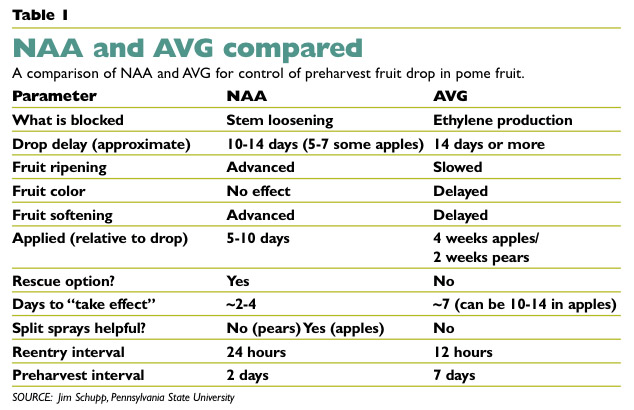VG is a substituted amino acid derived via fermenting the naturally occurring antibiotic rhizobitoxine. After its activity was discovered in 1972, it received a federal Experimental Use Permit in 1995 and a Section 2C label in 1997. It is formulated by Valent BioSciences as a 15% active ingredient wettable powder under the trade name ReTain. AVG is approved for organic use, but check acceptability with individual certifiers.
AVG temporarily inhibits ethylene biosynthesis by blocking the vital enzyme ACC synthase, required in the ethylene synthesis pathway. This contrasts with NAA, which acts strictly as an abscission control agent, and often hastens ripening. Since AVG delays ripening, fruit can hang an extra five to ten days or more to size. This may also enable a more orderly harvest using fewer workers, especially in blocks and cultivars that mature rapidly, such as Red Clapp’s Favorite, Bartlett, and perhaps Bosc in some years.
 AVG timing—AVG has shown more consistent effects on apple than on pear, partially because pears produce much less ethylene on the tree than apples, making spray timing more difficult. Timing is critical because once ethylene autocatalysis (ethylene synthesis is promoted by the presence of ethylene) begins, AVG will be less or not effective. Timing will vary with fruit maturity, especially in years with extended bloom. AVG should be applied prior to the onset of the preclimacteric rise of ethylene in the fruit. Late-season fruit with high internal ACC synthase and ethylene levels will overcome some or all of the effect of AVG. Label timing for pears is one to two weeks prior to first anticipated normal harvest period of untreated fruit.
AVG timing—AVG has shown more consistent effects on apple than on pear, partially because pears produce much less ethylene on the tree than apples, making spray timing more difficult. Timing is critical because once ethylene autocatalysis (ethylene synthesis is promoted by the presence of ethylene) begins, AVG will be less or not effective. Timing will vary with fruit maturity, especially in years with extended bloom. AVG should be applied prior to the onset of the preclimacteric rise of ethylene in the fruit. Late-season fruit with high internal ACC synthase and ethylene levels will overcome some or all of the effect of AVG. Label timing for pears is one to two weeks prior to first anticipated normal harvest period of untreated fruit.
Cultivar—Most use in pears will likely be on early ripening cultivars that produce more ethylene on the tree, i.e., Red Clapp’s Favorite, Bartlett, and perhaps Bosc in some years.
AVG application considerations—The label calls for the addition of 0.05 to 0.1% organosilicone surfactant. Check the spreader type and rate, then spray a small area and allow it to dry to check for fruit spotting. Unlike NAA, which can be applied by air, AVG is always applied by ground in California.
AVG postharvest effects—AVG-treated fruit may be handled differently by packers, processors, and marketers compared to NAA-treated or untreated fruit. For example, about 30% of Bartlett pears are destined for cannery use in California. Since AVG delays maturity, plan carefully to ensure fruit quality is satisfactory to the possible range of buyers. AVG-treated apples have been shown to stay firmer, store longer, and develop less watercore than NAA-treated fruit, but, in some instances, AVG-treated fruit had slightly less sugar and color. Studies on pear have produced promising but inconsistent results, and research is ongoing in California. Inconsistencies might be due, in part, to the trial locations—both the need for a stop-drop and the uptake and action of a stop-drop may be influenced by environment. In addition to reduced firmness loss, better green color retention and reduced internal browning have been reported. Importantly, while the AVG treatment is generally thought to result in more uniformly mature fruit than no treatment, AVG cannot “even out” the ripening of variably mature fruit going into storage.
Once applied properly, AVG requires about seven days to diffuse into fruit cells, compared to one to four days for NAA. If effective, drop control lasts five to ten days, or more, depending on application timing. Effectiveness for 15 days has been reported for one pear cultivar.
Acknowledgements
The authors wish to thank the following individuals for their invaluable contributions to this article: Wes Autio, Michael Devencenzi, Don Elfving, Duane Greene, Andrew Macnish, Tory Schmidt, Jim Schupp, David Sugar, and Broc Zoller. Rachel Elkins is with University of California Cooperative Extension, Lake and Mendocino Counties; Kitren Glozer, Department of Plant Sciences, University of California, Davis; and Michael Devencenzi, Ag Pest Management and Research, Woodbridge, California.
Leave A Comment